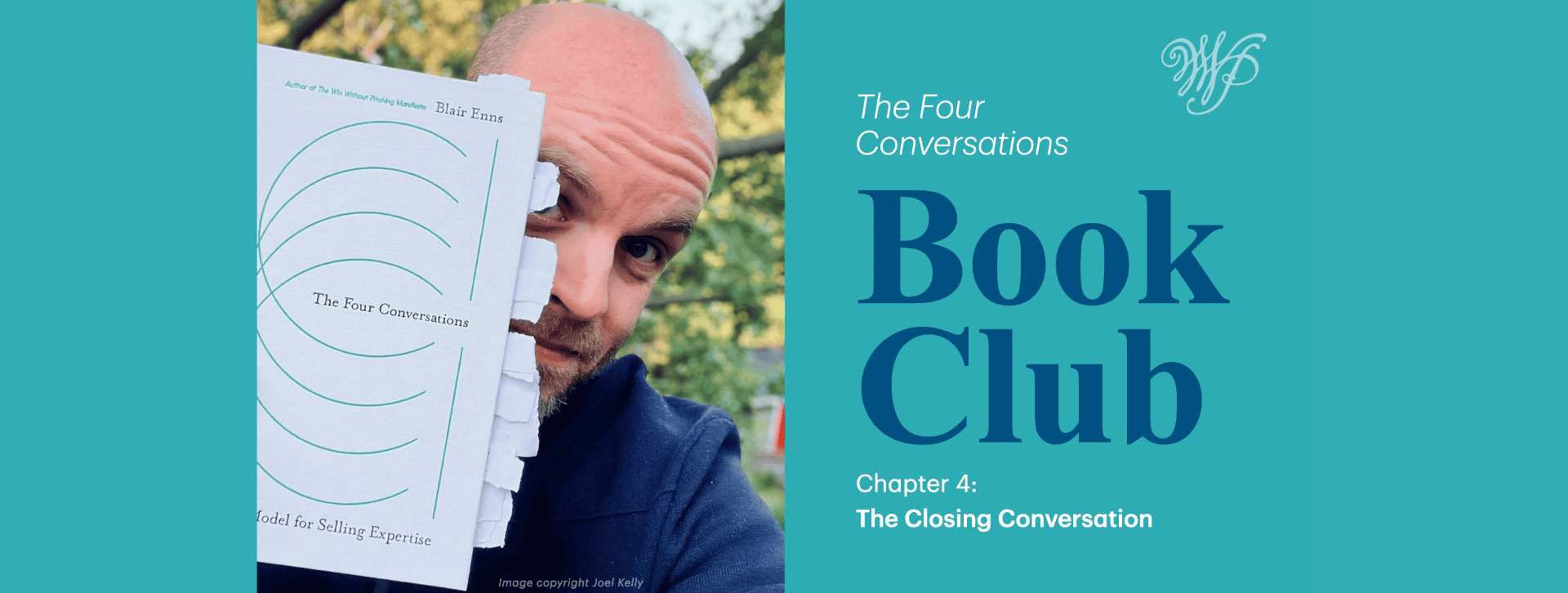Closing the sale, at the end, is where many experts double down, investing the most time and emotion to get things over the finish line.
It seems obvious and natural to do so.
In The Four Conversations model of selling expertise, however, when you handle the previous conversations properly, the fourth and final conversation that is The Closing Conversation becomes relatively straightforward and pressure-free.
The Four Conversations Book Club wrapped up last week, with over 800 people participating in a four-week conversation (one per week) on The Four Conversations. In last week’s final chapter on The Closing Conversation, I reviewed the key principles and frameworks then took questions for about an hour.
Your objective in The Closing Conversation is to help the client select and commit to a path forward.
Here are some of the highlights of the conversation on The Closing Conversation.
I work with fast paced document production. Can I combine all the conversations into one or two calls max?
Great question, Rafael. Yes you can. The more complex the sale, the decision maker dynamics, your offering or your pricing, the more likely the sale will be spaced out across many discussions.
At the other end of the spectrum, when selling a standardized service (i.e., productized) at a standardized price (i.e., you’ve priced the product and not the client) it’s possible to have the Qualifying, Value and Closing Conversations in one discussion, regardless of whether The Probative Conversation happened at all.
In the Book Club discussion on this I pointed out that there are two broad categories of implementation mistakes on The Four Conversations model. One category is those who play too loose with the framework, missing vital steps or components. But the second category is those who are too rigid in its application. To Rafael’s question, this latter camp can be guilty of dragging out the sale too long to fit the framework. If you can cover multiple Conversations in one discussion, do it.
Do you recommend sending the one page proposal shortly before the call and we chat together about it, or have a convo first then send the 1-pager?
Don’t send the proposal in advance. In a Zoom call or other virtual meeting I recommend you share your proposal (via screen share) only after you have delivered the anchor price.
For example, when you get to step five of The Closing Conversation framework (Share the options) you’ll set up the anchor option with something like, “I’d like to start with the most comprehensive and expensive of the options. It’s priced at [BOOM!]”
Now share your screen showing all three options. Give them a minute to have a glance around then start directing traffic again. “Let me walk you through it…”
Say the anchor price. Share your screen. Pause. Explain the anchor option. From there you can go where you like (the middle option or the budget option). My preference is to go the budget option and finish in the middle, which is a compromise between your grand vision and the client’s specific request.
Scoping and discovery for [multiple] options is a large sunk cost. One of the WWP principles is to sell with low sunk costs. But the research, brainstorming, and accurate predictive scoping seems unavoidable. Is the large sunk cost of scoping a necessary evil?
Great question, Sean. The answer is no, these sunk costs are entirely avoidable.
Any time you have to undertake a lot of work to write a proposal, you should get paid to do that work. You get paid by selling a diagnostic—any formalized research or discovery mechanism that allows you to collect the information you need to write a proposal.
Some firms always begin with a stand-alone diagnostic (typical in a highly technical sale) while some retain the flexibility to sell it as needed. You can close on a diagnostic early—at the end of a Qualifying Conversation—or a little later at the end of a Value Conversation.
In all but the firms that mandate first step stand-alone diagnostics, the need for the diagnostic is typically uncovered in The Value Conversation when the client can’t quantify KPIs or baseline data from which they would measure progress. (Yaakov had a question on this last week in The Value Conversation.)
There are other reasons to sell a diagnostic (e.g., to derail a pitch or get multiple decision makers on the same page), but in your case it sounds like the high level of scoping work you routinely encounter suggests you should formalize beginning all your engagements with a paid diagnostic. Be sure to include this step in your visual model that we discussed in The Qualifying Conversation.
-Blair
